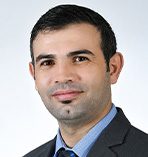
Khalifa University
Dr. Emad Alhseinat holds the position of Associate Professor in the Chemical and Petroleum Engineering Department at Khalifa University. Dr. Alhseinat has set up his laboratory at KU to focus on innovative techniques for water treatment and desalination. Dr. Alhseinat filed five patents at KU and has published many scientific publications in prestigious journals. Dr. Alhseinat is now an active member of the Center for Membranes and Advanced Water Technology (CMAT). His research is dedicated to addressing the issue of water scarcity in dry areas by enhancing the effectiveness of water desalination and treatment methods and developing inventive and sustainable solutions.
Water desalination accounts for around 80% of the overall water use in the United Arab Emirates (UAE). Nevertheless, the current desalination methods demonstrate considerable energy consumption and result in substantial expenses. Capacitive Deionization (CDI) is generally recognized as a very promising method for desalination. Furthermore, apart from the CDI's minimal energy demands, which surpass those of reverse osmosis in some situations, further energy conservation may be achieved by reclaiming a portion of the initial energy input. The harvested energy may be used to energize novel CDI cells, stored in other energy storage devices such as supercapacitors, or employed in any other manner. However, the broad adoption of CDI is hindered by the restricted scalability of the electrode material. Carbon derivatives are often used for the production of capacitive deionization electrode materials because of their excellent conductivity, chemical stability, and large surface area. Graphene stands out among carbon compounds owing to its exceptional electrical conductivity and surface area in comparison to other carbon materials. During the last five years, Dr. Alhseinat's team at KU has performed tests on several composites using graphene for capacitive deionization (CDI) [1-3]. Table 1 displays the experimental work conducted in our laboratory with electrodes made from graphene. Although graphene-based composites have shown a promising capacity to remove up to 65.1 mg g−1 in laboratory settings, their ability to be produced on a wide scale presents a substantial hurdle for their use in capacitive deionization (CDI) operations. During this presentation, Dr. Alhseinat will provide a concise overview of the basic principles of CDI and thereafter delve into the specific significance of the electrode material in determining CDI performance. Subsequently, an in-depth evaluation will be conducted to examine the benefits and limitations associated with the use of 2D materials, such as graphene and MXenes.
| Graphene electrode | Journal (publication date) | CDI removal (mg/g) |
|---|---|---|
| 3D graphene-MWCNT-MnO2 nanocomposites | Journal of Electroanalytical Chemistry (2022) | 65 [1] |
| α-MnO2/graphene | Electrochimica Acta (2020) | 30 |
| Sepiolite intercalated graphene (GS) and silver (Ag)-doped sepiolite intercalated graphene (AGS) | Separation and Purification Technology (2019) | 21 |